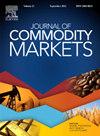The midstream amplifier: Risk spillovers in China's lithium supply chain from mining to batteries
IF 4.5
4区 经济学
Q1 BUSINESS, FINANCE
引用次数: 0
Abstract
The global energy transition has significantly increased the demand for lithium resources, raising market concerns about the stability of the global lithium supply chain. Understanding the relationships among different commodities within this supply chain is crucial for managing associated risks. In this study, we apply a time-varying parameter vector autoregression model to investigate the spillover effects and dynamic dependency of price volatility across the lithium supply chain. Our results reveal a high degree of systemic risk among lithium supply chains. Specifically, the risk spillover from the midstream segment to the upstream segment is the strongest and increasing, while the risk spillover to the downstream segment is the weakest and showing a downward trend. Additionally, the midstream serves as the primary net transmitter of price shocks, whereas the upstream and downstream segments more often act as net receivers. We identify two main pathways for the spillover of price shocks: one from the midstream to the upstream and then to the downstream, and another directly from the midstream to the downstream. These findings are important for mitigating the accumulation of risks within the lithium supply chain.
中游放大器:中国锂供应链从采矿到电池的风险溢出效应
全球能源转型显著增加了对锂资源的需求,引发了市场对全球锂供应链稳定性的担忧。了解供应链中不同商品之间的关系对于管理相关风险至关重要。本文采用时变参数向量自回归模型,考察了锂供应链价格波动的溢出效应和动态依赖关系。我们的研究结果表明,锂供应链存在高度的系统性风险。其中,中游向上游的风险溢出最强且呈上升趋势,而下游的风险溢出最弱且呈下降趋势。此外,中游是价格冲击的主要净发送者,而上游和下游部分通常是净接收者。我们确定了价格冲击溢出的两条主要途径:一条是从中游到上游,然后再到下游,另一条是从中游直接到下游。这些发现对于减轻锂供应链中的风险积累非常重要。
本文章由计算机程序翻译,如有差异,请以英文原文为准。
求助全文
约1分钟内获得全文
求助全文
来源期刊

Journal of Commodity Markets
Multiple-
CiteScore
5.70
自引率
2.40%
发文量
53
期刊介绍:
The purpose of the journal is also to stimulate international dialog among academics, industry participants, traders, investors, and policymakers with mutual interests in commodity markets. The mandate for the journal is to present ongoing work within commodity economics and finance. Topics can be related to financialization of commodity markets; pricing, hedging, and risk analysis of commodity derivatives; risk premia in commodity markets; real option analysis for commodity project investment and production; portfolio allocation including commodities; forecasting in commodity markets; corporate finance for commodity-exposed corporations; econometric/statistical analysis of commodity markets; organization of commodity markets; regulation of commodity markets; local and global commodity trading; and commodity supply chains. Commodity markets in this context are energy markets (including renewables), metal markets, mineral markets, agricultural markets, livestock and fish markets, markets for weather derivatives, emission markets, shipping markets, water, and related markets. This interdisciplinary and trans-disciplinary journal will cover all commodity markets and is thus relevant for a broad audience. Commodity markets are not only of academic interest but also highly relevant for many practitioners, including asset managers, industrial managers, investment bankers, risk managers, and also policymakers in governments, central banks, and supranational institutions.
 求助内容:
求助内容: 应助结果提醒方式:
应助结果提醒方式:


